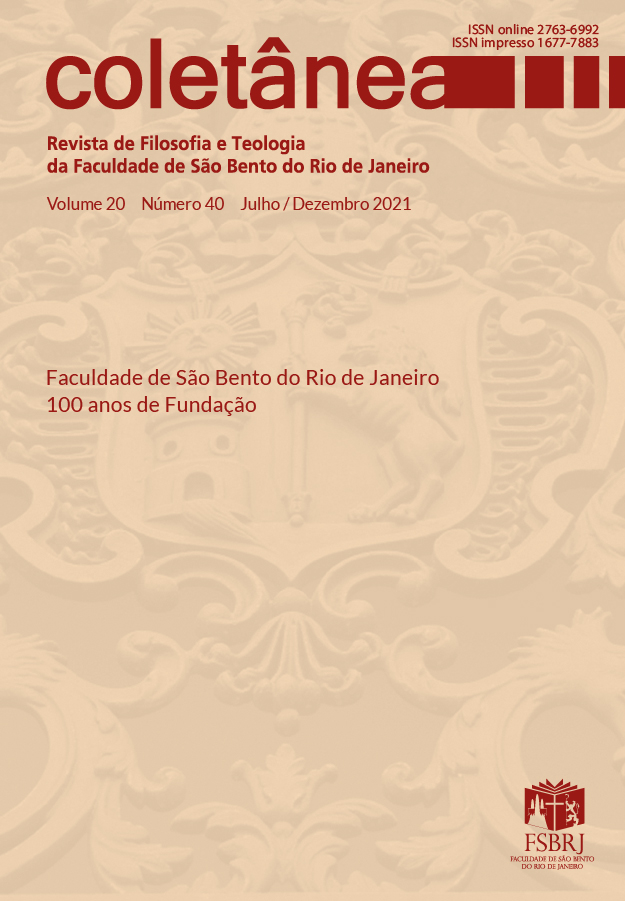A função teológica da metonímia em Rm 9,24-29 e Ef 1,3-10
Resumo
A ação divina em Rm 9,24-29 é destacada por Paulo, mediante a dinâmica do chamado que inicia uma sequência de provas bíblicas, enquanto ponto de partida histórico e eclesiológico da compreensão paulina sobre a origem e a natureza dos fiéis que formam uma comunidade (Rm 9,24). O chamado é uma ação fruto, exclusivamente, de Deus (Rm 9,12) e historicamente, gera fiéis em Cristo (Rm 9,24). Em Ef 1,3-10, a eleição de Deus inaugura as ações divinas descritas na perícope, que possuem em Cristo o meio da sua realização histórica. Além disso, tanto em Rm 9,24-29 como em Ef 1,3-10 se destacam as ocorrências dos particípios substantivados “amada” e “amado”. Estes ocorrem apenas três vezes no corpus paulinum: duas vezes em Rm 9,25 e uma vez em Ef 1,6. Tais particípios substantivados são, de fato, uma metonímia referida à Igreja e a Jesus Cristo, indicando o modo como Deus cumulou de graça os fiéis.
Palavras-chave: Amado. Metonímia. Igreja. Cristo. Rm 9,24-29. Ef 1,3-10.
Referências
ALETTI, J.-N. La dispositio rhétorique dans les épîtres pauliniennes. Propositions de méthodes. New Testament Studies, v. 38, n. 3, Jul. 1992, p. 385-401.
________. Paul et la rhétorique. État de la question et proposition. In: SCHLOSSER, J. (Ed.). Paul de Tarse. Congrès de l’ACFEB (Strasbourg 1995). LeDiv 165. Paris: Cerf, 1996, p. 27-50.
________. Israël et la loi dans la Lettre aux Romains. LeDiv 173. Paris: Cerf, 1998.
________. Saint Paul: Épître aux Éphésiens. EtB 42. Paris: J. Gabalda, 2001.
________. La rhétorique paulinienne. Construction et communication d’une pensée, In: DETTWILER, A.; KAESTLI, J.-D.; MARGUERAT, D. (Eds.). Paul, une théologie en construction. MoBi 51. Genève: Labor et Fides, 2004, p. 47-66.
________. La Lettera ai Romani. Chiave di lettura, NVE. Roma: Borla, 2011.
________. “La cristologia delle lettere paoline. Status quaestionis e nuovi orientamenti”. In: Seminario di aggiornamento per studiosi e docenti di S. Scrittura (06. 2017: Pontificio Istituto Biblico, Roma), Epistolario paolino. Lettere ai Galati e ai Romani. Seminario per gli studiosi di Sacra Scrittura. Roma, 23-27 Gennaio 2017, e-biblicum 3, 2017, p. 27-44.
AL-SHARAFI, A. G. M. Textual Metonymy: A Semiotic Approach. New York: Palgrave Macmillan, 2004.
ANDERSON JR., R. D. Glossary of Greek Rhetorical Terms Connected to Method of Argumentation, Figures and Tropes from Anaximenes to Quintilian. CBET 24. Leuven: Peeters, 2000.
BARCLAY, W. New Testament Words. Louisville: Westminster John Knox Press, 1964.
BARTH, M. Ephesians 1–3. AncB 34. Garden City: Doubleday, 1974.
BASEVI, C. La benedizione di Ef 1,3-14. Il disegno di salvezza di Dio Padre. Annales Theologici, v. 14, n. 2, 2000, p. 305-342.
BELLI, F. Argumentation and Use of Scripture in Romans 9–11. AnBib 183. Roma: Gregorian & Biblical Press, 2010.
BERGER JR., H. Figures of a Changing World: Metaphor and the Emergence of Modern Culture. New York: Fordham University Press, 2015.
BERISTÁIN, H. Diccionario de retórica y poética. México: Editorial Porrúa, 1985, 19957.
BEST, E. Ephesians. NTG. Sheffield: Sheffield Academic Press, 1997.
BIANCHINI, F. L’analisi retorica delle lettere paoline: Un’introduzione. Comprendere la Bibbia. Cinisello Balsamo: San Paolo, 2011.
BUSCEMI, A. M. Gli inni di Paolo: Una sinfonia a Cristo Signore. ASBF 48. Jerusalem: Franciscan Printing Press, 2000.
CICERO. Orator. In: Opere retoriche di M. Tullio Cicerone, a cura di G. NORCIO, Classici UTET. Classici latini, Torino, 1976.
DIONÍSIO DE HALICARNASSO. De compositione verborum, a cura di AUJAC, G.; LEBEL, M. CUFr, Paris, 1981.
DREWS, L. “Antonomasie”. In: UEDING, G.; KALIVODA, G.; KAZICH, O. (Eds.). Historisches Wörterbuch der Rhetorik, I. Tübingen, 1992-2014; Berlin – Boston, 2015, p. 753-754.
EGGS, E. “Metonymie”. In: UEDING, G.; KALIVODA, G.; KAZICH, O. (Eds.). Historisches Wörterbuch der Rhetorik, V. Tübingen, 1992-2014; Berlin – Boston, 2015, p. 1196-1223.
FABRIS, R.; ROMANELLO, S. Il genere epistolare e le lettere di Paolo. In: ________. (Eds.). Introduzione alla lettura di Paolo. NVE. Roma: Borla, 2006, 20092, p. 103-131.
FOSTER, R. L. Reoriented to the Cosmos. Cosmology and Theology in Ephesians through Philemon. In: PENNINGTON, J. T.; MCDONOUGH, S. M. (Eds.). Cosmology and New Testament Theology. LNTS 355. London – New York: T&T Clark, 2008, p. 107-124.
GARCÍA BARRIENTOS, J. L. Las figuras retóricas: El lenguaje literario 2. Cuadernos de Lengua Española 56. Madrid: Arco Libros, 1997.
GARUTI, P. La cohérence des images sacrificielles dans l’épître aux Éphésiens (Ep 2,16; 5,2). Revue Biblique, v. 122, n. 4, Oct. 2015, p. 592-608.
GLENNY, W. E. “The People of God” in Romans 9:25-26. Bibliotheca Sacra, v. 152, Jan.-Mar. 1995, p. 42-59.
HAHN, F. Observations on the Soteriology of the Letters to the Colossians and Ephesians. In: CHRISTOPHERSON, A.; CLAUSSEN, C.; FREY, J.; LONGENECKER, B. (Eds.). Paul, Luke and the Graeco-Roman World. Fs. A.J.M. Wedderburn, JSNTSup 217. New York: Sheffield Academic Press, 2002, p. 123-135.
HAYS, R. B. Echoes of Scripture in the Letters of Paul. New Haven – London: Yale University Press, 1989.
HOEHNER, H. W. Ephesians: An Exegetical Commentary. Grand Rapids: Baker, 2002.
JEANROND, W. G. A Theology of Love. London – New York: Bloomsbury, 2010.
LAUSBERG, H. Elemente der literarischen Rhetorik: Eine Einführung für Studierende der klassischen, romanischen, englischen und deutschen Philologie. Ismaning: Max Hueber Verlag, 1963.
LÁZARO, T. O. “Todo en todos”: Cristología de Col y Ef. Estudios bíblicos, v. 68, n. 1, 2010, p. 31-52.
LE GUERN, M. Sémantique de la métaphore et de la métonymie. Langue et Langage Paris: Larousse, 1973.
LEVINE, E. Heaven and Earth, Law and Love. Studies in Biblical Thought, BZAW 303. Berlin – New York: De Gruyter, 2000.
LINCOLN, A. T. Ephesians. Word Biblical Commentary v. 42. Dallas: Thomas Nelson, 1990.
MARCHESE, A. Dizionario di retorica e di stilistica: Arte e artificio nell’uso delle parole retorica, stilistica, metrica, teoria della letteratura. Milano: Mondadori, 1978, 19912.
MARCHESELLI, M. “Amore (NT)”. In: PENNA, R.; PEREGO, G.; RAVASI, G. (eds.). Temi teologici della Bibbia. DSP. Cinisello Balsamo: Edizioni San Paolo, 2010, p. 34-42.
MAZUR, R. La retorica della Lettera agli Efesini, ASBF 75. Jerusalem – Milano: Edizioni Terra Santa, 2010.
MORIER, H. Dictionnaire de poétique et de rhétorique. Paris: P.U.F., 1961, 19752.
MORTARA GARAVELLI, B. Manuale di retorica. Studi Bompiani, Italianistica. Milano: Bompiani, 1988.
MOUTON, E. The Transformative Potential of Ephesians in a Situation of Transition. Semeia, v. 78, 1997, p. 121-143.
NAMGUNG, Y. Paul’s Use of Quotations in Romans 1–11. Methodological Considerations. Journal of Early Christian History, v. 6, n. 1, 2016, p. 78-96.
NERLICH, B. “Metonymy”. In: BROWN, K. (Ed.). Encyclopedia of Language and Linguistics, VIII. Oxford: Elsevier, 2006, p. 109-112.
PENNA, R. Lettera agli Efesini, SOCr 10. Bologna: EDB, 1988.
PITTA, A. Disposizione e messaggio della Lettera ai Galati: Analisi retorico-letteraria. AnBib. Roma: Gregorian & Biblical Press, 1992.
________. Così “inesperto nell’arte retorica”? (cfr. 2Cor 11,6). Retorica e messaggio paolino. In: ________. Il paradosso della croce: Saggi di teologia paolina. Casale Monferrato: Piemme, 1998, p. 411-435.
________. Lettera ai Romani. LB.NT 6. Milano: Paoline, 2001.
QUELL, G.; STAUFFER, E. “ἀγαπάω, ἀγάπη, ἀγαπετóς”. In: KITTEL, G.; FRIEDRICH, G. (Eds.). Theologisches Wörterbuch zum Neuen Testament, I. Stuttgart, 1933-1979, p. 20-55.
QUINTILIANO, M. F. Institutio oratoria, VIII-IX, a cura di COUSIN, J. CUFr 5, Paris, 1978.
ROBERT, S. Words and Their Meanings. Principles of Variation and Stabilization. In: VANHOVE, M. (Ed.). From Polysemy to Semantic Change. Towards a Typology of Lexical Semantics Associations, SLCS 106. Amsterdam – Philadelphia: John Benjamins, 2008, p. 55-92.
ROMANELLO, S. Una legge buona ma impotente: Analisi retorico-letteraria di Rm 7,7-25 nel suo contesto. SRivBib 35. Bologna: EDB, 2000.
________. Lettera agli Efesini, LB.NT 10. Milano: Paoline, 2003.
ROWE, G. O. Style. In: PORTER, S. E. (Ed.). Handbook of Classical Rhetoric in the Hellenistic Period – 330 B.C.-A.D. 400. Leiden – New York – Köln: Brill, 1997, p. 121-158.
RYLIŠKYTĖ, L. God’s Mercy. The Key Thematic Undercurrent of Paul’s Letter to the Romans. The Catholic Biblical Quarterly, v. 81, n. 1, Jan. 2019, p. 85-105.
SCOTT, J. W. The Time When Revelatory Gifts Cease (1Cor 13:8-12). Westminster Theological Journal, v. 72, n. 2, 2010, p. 267-289.
SILK, M., Metaphor and Metonymy. Aristotle, Jakobson, Ricoeur, and Others. In: BOYS-STONES, G. R. (Ed.). Metaphor, Allegory, and the Classical Tradition: Ancient Thought and Modern Revisions. London – New York: Oxford University Press, 2003, p. 115-147.
STANLEY, C. D. Paul and the Language of Scripture: Citation Technique in the Pauline Epistles and Contemporary Literature. NTSMS 69. Cambridge: Cambridge University Press, 1992.
STEYN, G. J. Observations on the Text Form of the Minor Prophets Quotations in Romans 9–11. Journal for the Study of the New Testament, v. 38, n. 1, 2015, p. 49-67.
TANNER, J. P. The New Covenant and Paul’s Quotations from Hosea in Romans 9:25-26. Bibliotheca Sacra, v. 162, Jan.-Mar. 2005, p. 95-110.
THOMPSON, J. W. Moral Formation according to Paul: The Context and the Coherence of Pauline Ethics. Grand Rapids: Baker, 2011.
TRAVERS, M. E. The Use of Figures of Speech in the Bible. Bibliotheca Sacra, v. 164, n. 655, Jul.-Sep. 2007, p. 277-290.
TREMOLADA, P. “Volontà di Dio”. In: PENNA, R.; PEREGO, G.; RAVASI, G. (eds.). Temi Teologici della Bibbia. DSP. Cinisello Balsamo: Edizioni San Paolo, 2010, p. 1532-1539.
VIAU, M. L’univers esthétique de la théologie. Montréal: Médiaspaul, 2002.
WAGNER, J. R. Heralds of the Good News: Isaiah and Paul in Concert in the Letter to the Romans. Leiden – Boston: Brill, 2003.
WÉNIN, A. “Alleanza”. In: PENNA, R.; PEREGO, G.; RAVASI, G. (eds.). Temi Teologici della Bibbia. DSP. Cinisello Balsamo: Edizioni San Paolo, 2010, p. 23-31.
YEE, G. A. “She Is Not My Wife and I Am Not Her Husband”: A Materialist Analysis of Hosea 1–2. Biblical Interpretation, v. 9, n. 4, 2001, p. 345-383.
ZIEGLER, J. (Ed.). Duodecim prophetae. Septuaginta 13. Göttingen: Vandenhoeck & Ruprecht, 1943, 19672.
Downloads
Publicado
Edição
Seção
Licença
Os Autores mantêm os direitos autorais e ao mesmo tempo, concedem cessão dos mesmos direitos autorais à Revista Coletânea que passa ter plenos direitos de publicação, com o trabalho simultaneamente licenciado sob a Licença Creative Commons Attribution que permite o compartilhamento do trabalho com reconhecimento da autoria e publicação inicial nesta revista. As publicações deste periódico poderão ser reproduzidas desde que devidamente referenciadas, conforme a licença adotada.













